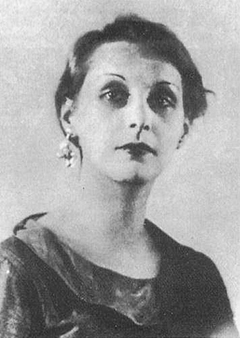

Husband Henry Miller, partner Jean Kronski
Queer Places:
Valley View Cemetery, 1021 AZ-89A, Clarkdale, AZ 86324
 June
Miller (January 7 or 28, 1902 – February 1, 1979)[1][2]
was the much-written-about second wife of
Henry Miller.
June
Miller (January 7 or 28, 1902 – February 1, 1979)[1][2]
was the much-written-about second wife of
Henry Miller.
She was born in Bukovina, Austria-Hungary (of Romanian origin as mentioned in Sexus) as Juliette Edith Smerdt, the daughter of Wilhelm and Frances Budd Smerdt, a poor Jewish family. She emigrated with her parents and four siblings to the United States in 1907. At the age of 15, she dropped out of high school to become a dancer at Wilson's Dancing Academy (renamed the Orpheum Dance Palace in 1931) in Times Square and began going by the name June Mansfield, occasionally going by June Smith.[3][4] In Sexus, Henry Miller writes that June claimed she graduated from Wellesley College, but in Nexus, he writes that she never finished high school. Kenneth Dick, after interviewing June, quotes her as saying, "My formal education amounted to about three and a half years of high school. I was working on a scholarship to Hunter College."[4]
She would reside in New York City for much of the rest of her life, excepting a tour of Europe and stints in Paris and Arizona.
In 1923, at Wilson's, she met Henry Miller, when she was 21 and he was 31. Miller left his first wife and child to marry June in Hoboken, New Jersey on June 1, 1924.[5] Their relationship is the main subject of Miller's semi-autobiographical trilogy, The Rosy Crucifixion. June is also featured in his best-known works, Tropic of Cancer and Tropic of Capricorn.
In October 1926, Jean Kronski, an artist and poet, moved in with them at June's urging.[6] June, who was likely bisexual, cultivated a very close relationship with Jean, often preferring Jean's affections to Henry's. This living arrangement soon fell apart and Jean and June left for Paris together in April 1927. However, two months later they started to quarrel, and June returned to Henry in July.[7] The following year, June and Henry left for a tour of Europe, settling in Paris for several months before again returning to New York.[8] June's relationship with Jean is the central piece of Henry's autobiographical novels Crazy Cock (1930, unpublished until 12 years after Miller's death) and Nexus (1959), the third volume of The Rosy Crucifixion. Around 1930, Kronski committed suicide in an insane asylum in New York.[9]
In 1930, Henry moved to Paris unaccompanied. In 1931, while visiting Henry, June met writer Anaïs Nin, who quickly became obsessed with her and, just as Henry did, used her as a biographical archetype in many of her subsequent writings. June and Nin became involved in a flirtatious relationship although Nin denied it was sexual. However, June would figure prominently in her published and unpublished diaries, upon which the movie Henry & June was loosely based. In the film, she was portrayed by Uma Thurman. June was not pleased with the publication of Nin's expurgated diaries, which omitted Nin's affair with Miller and thus omitted the role Nin played in the breakup of the Millers's marriage.[10]
June and Henry divorced by proxy in Mexico City in 1934.[4][11]
After divorcing Miller, she married insurance salesman Stratford Corbett around 1935.[4] Corbett had been courting her when Miller left for Paris in 1930, and it upset Miller greatly when he found out that June and Corbett were together.[12] Stratford left her in 1947 for the actress Rita La Roy Corbett.[4] June's life deteriorated at this point and she lived in a series of cheap hotels around New York City, such as the Hotel Continental on 95th Street. She was in touch with Miller during this period through the post, and he sent her money through friends and bookstores such as the Gotham Book Mart.[13] The notebooks Miller kept on his 1940 trip across the United States that would become The Air-Conditioned Nightmare included a handful of stray references to June. One reads, "Sit here dreaming of June. Where now, little June? Are you happy?"[14]
During the 1950s, June was admitted to psychiatric wards where she received electric shock treatments, during which she broke several bones after falling off the operating table. She never fully recovered. In 1954, she began volunteering as a social worker. In 1957, she became an intern receptionist at the city welfare department, and was working for the department full-time by 1960. In 1961, she met Miller again; he was shocked at her deterioration, and the two never rekindled their relationship.[13][15] In the late 1960s, June moved to Arizona with one of her brothers. The grave of "June E. Corbett, beloved sister," in the Valley View Cemetery in Cottonwood, Arizona, is probably hers.[16]
Although she expressed a desire to write an autobiography, she never wrote anything other than letters. However, she had enormous literary influence over the works of her ex-husband Miller and Anaïs Nin. She died in Arizona in 1979.
My published books: